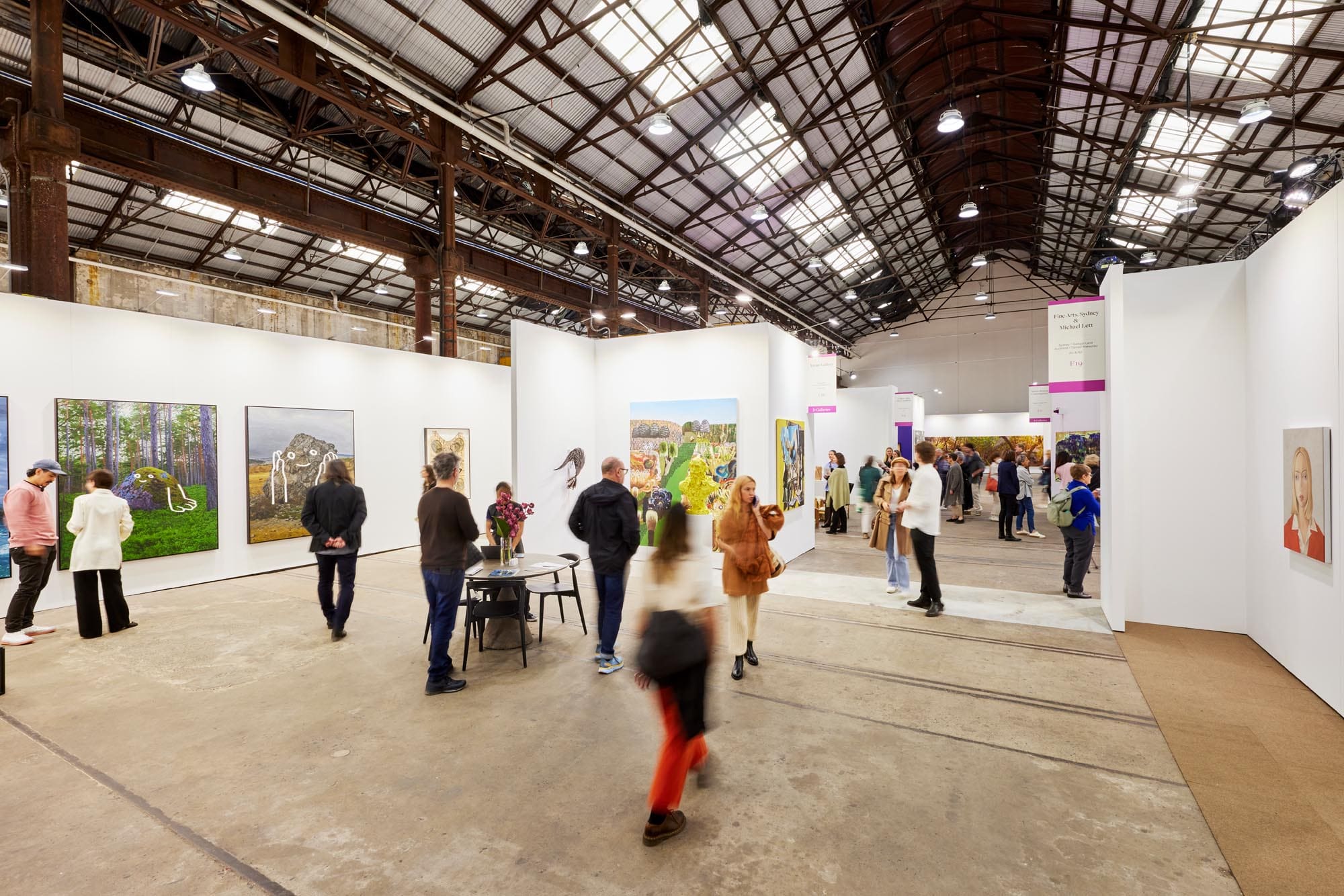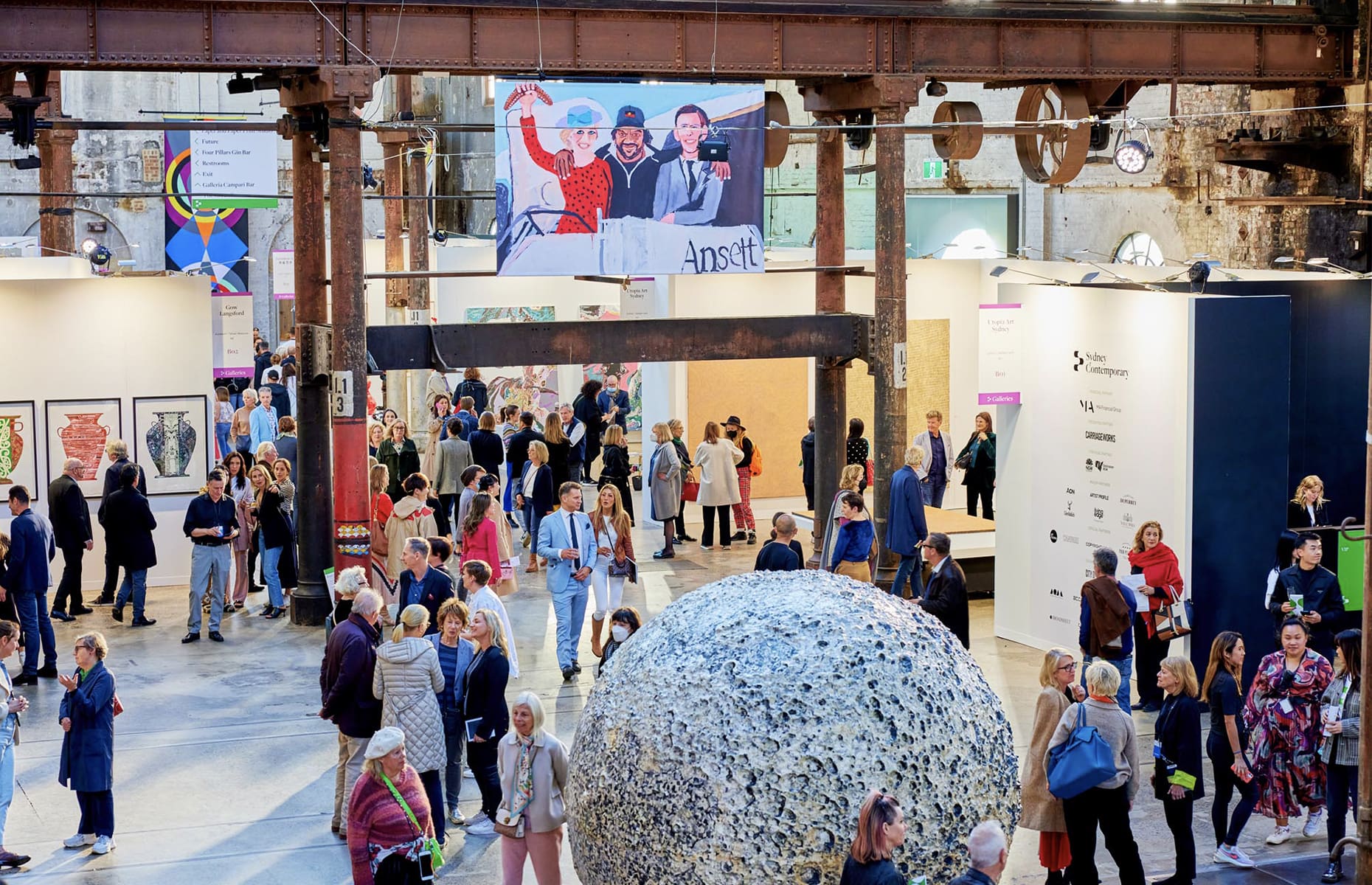Sydney Contemporary opened today at Carriageworks for a four-day program of art, performance, talks, food and drink after spending two years online due to COVID-19 restrictions.
Across the four days, the art fair will play host to 450 artists hailing from 34 nations, 90 galleries, alongside 150 events. Artists represented at the fair range from emerging to established, with National Art School (NAS) students exhibiting just metres from some of Australia’s most acclaimed contemporary artists including Lindy Lee, Vincent Namatjira, and Bill Henson.
Between the high prices and big names, Sydney Contemporary can easily become an intimidating space for members of the public to visit. The 90 gallery-booths amassed together transform Carraigeworks’ cavernous space into one alive with activity and colour — the fair format is distinctly set apart from the sometimes affronting nature of large institutional galleries.
Despite the sales produced by the festival being the focal point for its founder (historically $18 million in 2019), purchasing what may be your first work of art as a student isn’t necessarily out of reach — with works ranging from as low as $40.

If buying art isn’t your thing, another unique disparity between the festival and a regular gallery experience is sheer the breadth of art on display both in aesthetic and material qualities. There is nearly no other singular location in Sydney with such a substantive range of art. With so many options visual fatigue is quickly onset, however, the artists themselves are present throughout the four-day event and ready to discuss their work in accessible ways.
Considering accessibility both in terms of the financial and intellectual barriers embedded within art, the showings from National Art School (NAS) students is well-worth checking out.
NAS has brought eight students to the festival in a notable divergence from the other exhibiting institutions in attendance. Though some galleries may be representing artists who are students, NAS is the only group attending the festival who is an educating body, solely representing the work of students.
Honi spoke with the senior curator of NAS, Katrina Cashman, to hear about the opportunities granted to student artists exhibiting at Sydney Contemporary.
Cashman explained that Sydney Contemporary is “a platform that shows their work to thousands,” and can act as a “curatorial stepping stone” through which students are able to launch a career in fine arts and connect with industry representation, galleries, and dealers.
The ways in which NAS’ presence at the festival is unique was also touched upon by Cashman, she explained that their booth critically contributes to a “democratisation of art”. Wherein the presence of the school and its students — who are only beginning to develop their artistic practice — creates an entry-level space for both young artists and festival attendees to engage with art.
Cashman herself notes that the ‘white-cube’ space of many galleries, and many booths present, is often a deterrent for new viewers of art. Pointing to the layout of their space, the NAS booth has works of art that extend beyond the confines of their cube and into the walkway to create a space that individuals can walk freely into and around.
With its principal partner in the enterprise being MA Financial Group, it would be natural to assume that the audience of Sydney Contemporary is solely composed of investors and corporations. However, there’s still plenty of work at the art fair to be enjoyed by either an art-loving public or the discerning collector, even if they may not be in your price range. Lindy Lee stuns with a 1.8m circumference circle of her signature organic metallic forms, in this case sculpted through the interaction of molten silver with a bed of sand.
Within the collections of Paper works — a section dedicated to print-making, watercolour, and other prints on paper — a showing from Damien Minton shines. Minton showcases a collection of political posters taken from across Australian history, all the way from ‘Give Fraser the Razor’ to the anti-ScoMo bin stickers of the 2022 Federal Election.
Within his collection, Minton boasts a group of political posters from USyd’s very own Tin Sheds — a historic campus site of politicised art-making across the 1970s to 80s. Students who were part of the Sheds formed radical collectives such as the Lucifoil and EarthWorks poster collectives to create infamous works such as No Nukes in the Pacific by Pam Debenham and several works by Judy Kuo.
Minton also showcases contemporary left-wing political art, most notably Sam Wallman’s Our Members be Unlimited, a series of comics exploring Australian unionism and workers’ rights.
There’s plenty to do and see at Sydney Contemporary for all kinds of arts-lovers, even if you don’t pull out your wallet. And if all else fails, the event is decked out with a Campari bar, Gin bar, Champagne bar, Glenfiddich bar, and a wine bar.
Sydney Contemporary is open until Sunday September 11th, see the full lineup of events here.





